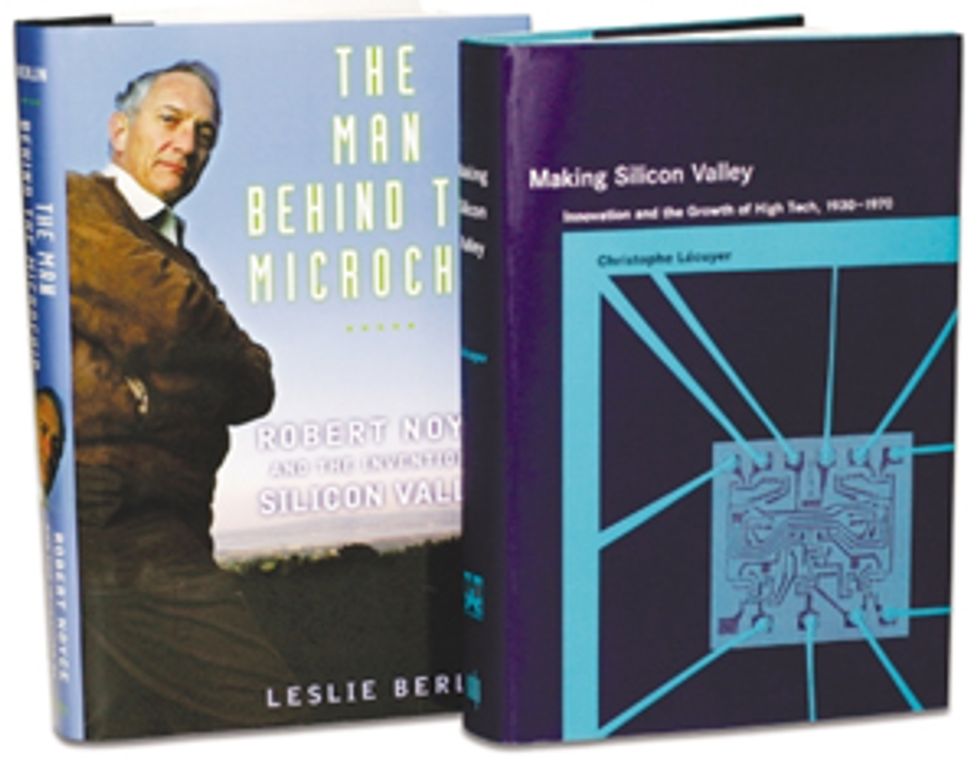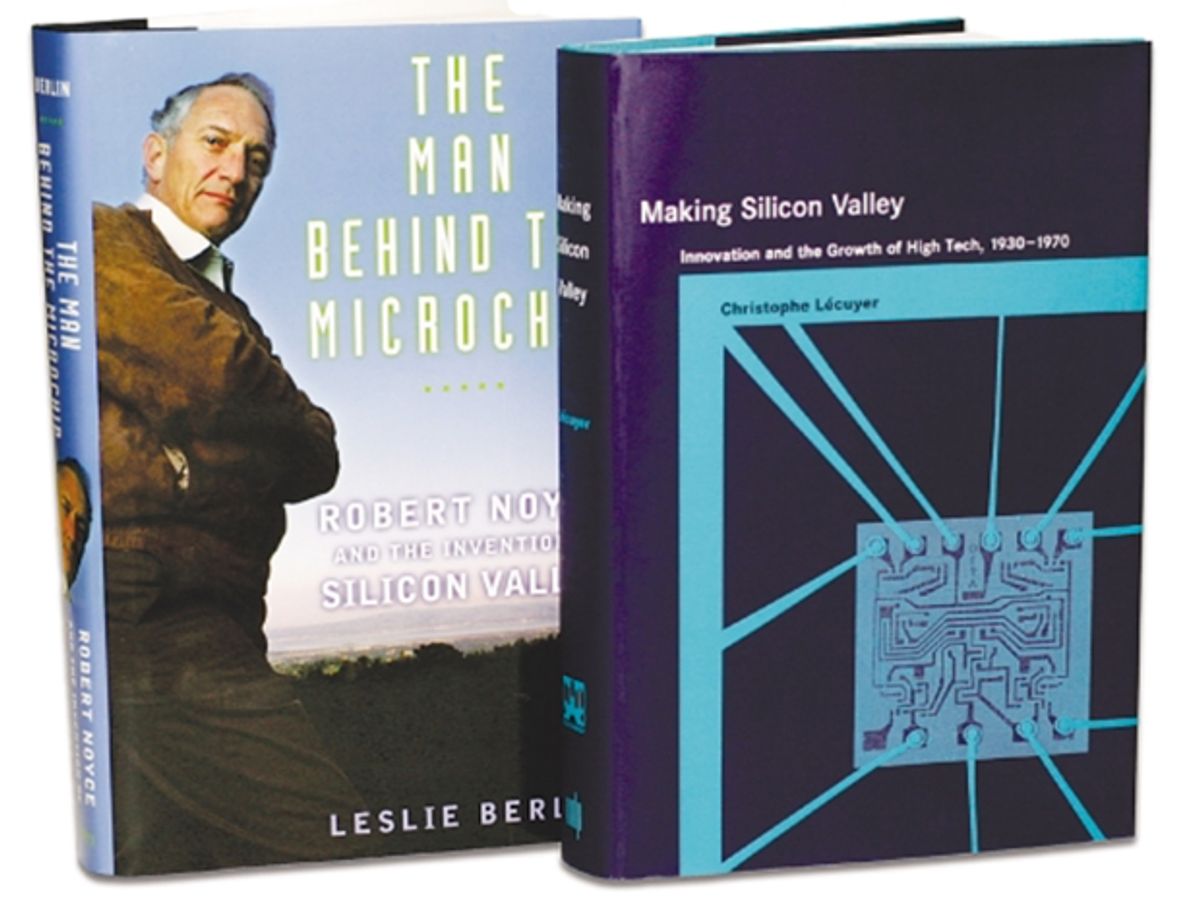
In mid-April 1956, a young Robert Noyce sped cross-country in his car to join his new colleagues at Shockley Semiconductor Laboratory in Mountain View, Calif. He arrived just in time for a raucous party celebrating the company’s launch, downed a pitcher of martinis, and promptly passed out.
Blissfully unaware of it then, Noyce was soon to become a central figure in a tectonic shift in American industry. He had just left a position in the aging industrial heartland of the East, where he developed high-frequency germanium transistors at Philadelphia-based Philco Corp., for a far-sighted start-up on the San Francisco Peninsula. Shockley Semiconductor was bent on fabricating transistors in the much more challenging, but promising, element silicon. Later, as head of Fairchild Semiconductor Corp. in the 1960s and after that Intel Corp., he played a leading role in establishing what became Silicon Valley—still the throbbing heart of the US $200 billion semiconductor industry.
Leslie Berlin has written an engaging biography of Noyce, The Man Behind the Microchip. She began the project almost a decade ago as a Ph.D. dissertation at Stanford University, in California, and then spent several years expanding her thesis into this book. Thoroughly researched and well written, it offers revealing insights into the life of the man who became an iconic public figure for the industry. The aggressive, charismatic, risk-taking physicist with the broad, infectious smile returns to life in Berlin’s easy-to-read narrative. More than anyone else, it was Noyce who spawned the laid-back, egalitarian management style so characteristic of the Valley. He also enjoyed, as he put it, “walking the thin line next to the cliff of disaster.”
Noyce learned the new silicon technologies while working for Nobel laureate William Shockley, one of the transistor’s inventors, who brought most of the methods west with him from Bell Telephone Laboratories, in Murray Hill, N.J. The young scientists and engineers he hired pushed the limits of the technologies, but they eventually deserted Shockley in 1957 to found their own start-up firm, Fairchild, because they could no longer tolerate his heavy-handed management. At Fairchild in 1959, Noyce conceived and patented the ideas that were to form the basis of integrated-circuit manufacturing.
All that is standard lore, well known to anyone familiar with the history of the semiconductor industry. Much less familiar is the fact that after suggesting that integrated circuits could be made with silicon using the planar manufacturing process, invented by his Fairchild colleague Jean Hoerni, Noyce had little involvement in their subsequent development. Turning Noyce’s proposal into a practical process fell to a group headed by Jay Last, another Fairchild founder. Last organized and led a team of scientists and engineers who painstakingly worked out the tools and techniques required to realize Noyce’s ideas in silicon—the messy details such as photolithography, precision masking, and electrical isolation of the individual chip components.
Although well aware of that twist, Berlin devotes few pages to it. The focus of her narrative is Noyce, who in March 1959 essentially left the laboratory bench for good, to step in as Fairchild’s new general manager. Readers who hunger for more information on the actual development of the microchip should turn to another Stanford Ph.D. dissertation converted into a book: Making Silicon Valley, by Christophe Lécuyer.
Various authors have emphasized the importance of Stanford, and particularly of its entrepreneurial provost, Frederick Terman, in promoting the rise of Silicon Valley. Not Lécuyer. In a dry, scholarly book, he stresses instead the gradual accumulation on the Peninsula of unrivaled manufacturing expertise, especially in product and process engineering. This trend emerged before World War II with the fabrication of high-power electron tubes and afterward shifted into microwave-tube manufacturing at companies such as Litton Industries and Varian Associates.
Lécuyer thus argues a solid high-tech industrial base already existed by the mid-1950s, when Shockley, Noyce, and other talented recruits such as Gordon E. Moore arrived to work on advanced silicon devices.
If Lécuyer has a hero, it is Hoerni, the Swiss-born physicist, educated at the California Institute of Technology, in Pasadena, who pioneered the planar process, in which impurities are diffused into the silicon surface to create the various electrical regions in a semiconductor device. He expounds at length on Hoerni’s conception and development of the technique, which Lécuyer boldly dubs “the most important innovation in the history of the semiconductor industry.”
Those are daring, perhaps reckless words. What about the transistor and integrated circuit? But they reveal the lens through which Lécuyer views semiconductor history. He focuses on production engineering rather than bold ideas and brilliant conceptions. Industrial innovations occur in the laboratory and on the shop floor as much as—or maybe even more than—in the minds of such “great men” as Noyce and Shockley.
Another unsung microchip hero who finally gets his due in Lécuyer’s book is Last, who headed the team that developed Fairchild’s Micrologic series of integrated circuits, the first ICs to reach the market. Along with Noyce, Last pioneered the use of photolithography to imprint intricate patterns of impurities and aluminum on the silicon surface. To fabricate microchips using the planar process required precise optical masks aligned to what was then almost incredible accuracy. With a deep understanding of physical optics, Last led the way. He also developed his own approach to electrical isolation of the individual chip components, but here Noyce’s original suggestion—to use pairs of p-n junctions—eventually won out.
By the time the Micrologic devices became available in March 1961, however, Last and Hoerni were no longer at Fairchild. They had left the company in late January to start Amelco Semiconductor, bringing with them other Fairchild cofounders and members of the IC development team. Half a year later, several remaining team members abandoned Fairchild to found yet another start-up, Signetics Corp. These were the first in a long series of Fairchild spin-offs—often called the “Fairchildren”—that seeded the fertile Valley with entrepreneurial new firms pursuing silicon technologies and manufacturing methods that the parent company had initiated but was not motivated to pursue. Last and Hoerni departed largely because they felt the company was not sufficiently interested in microchips, compared with its existing product lines of transistors and diodes. They formed Amelco to focus on integrated circuits. For the next few years, according to Lécuyer, it was Amelco and Signetics that advanced the frontiers of microchip manufacturing.
When it came to selling microchips to skeptical engineers, however, Fairchild had no equal. To Berlin, it was Noyce who paved the way, as he combined his boyish charm with a pioneering savvy to open lucrative commercial markets for the company’s semiconductor devices in computers and other electronics. Lécuyer credits the Fairchild marketing department and its systems engineers, who designed complex circuitry using its devices and literally gave the designs to customers. Both authors agree that Noyce made the key strategic decision to slash microchip prices in 1964, selling them for less than manufacturing costs. This drastic move undercut and effectively crushed such competitors as Signetics, helping Fairchild dominate the microchip market.
There is much more to both books, including Noyce’s central role in founding Intel with Moore after leaving Fairchild in 1968 and his later years as semiconductor industry spokesman. But after reading these two fine books in tandem, I am left with the nagging feeling that a more accurate title for Berlin’s would have been The Man Who Sold the Microchip. Of course, selling is an important aspect of making, or manufacturing, as anybody who has ever run a production company has learned—except perhaps William Shockley.
About the Author
Contributing editor Michael Riordan is co-author of Crystal Fire: The Birth of the Information Age. He teaches the history of physics and technology at Stanford University and the University of California, Santa Cruz.
